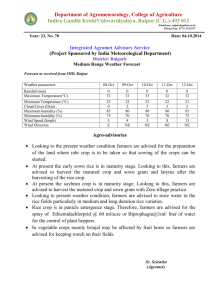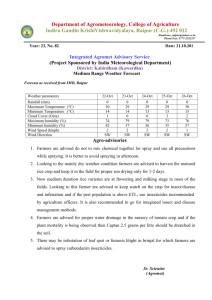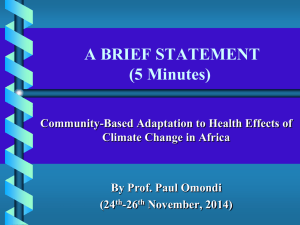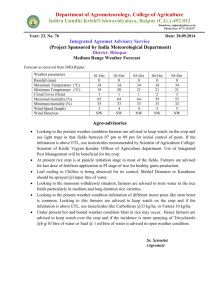ICRISAT - CCAFS
advertisement
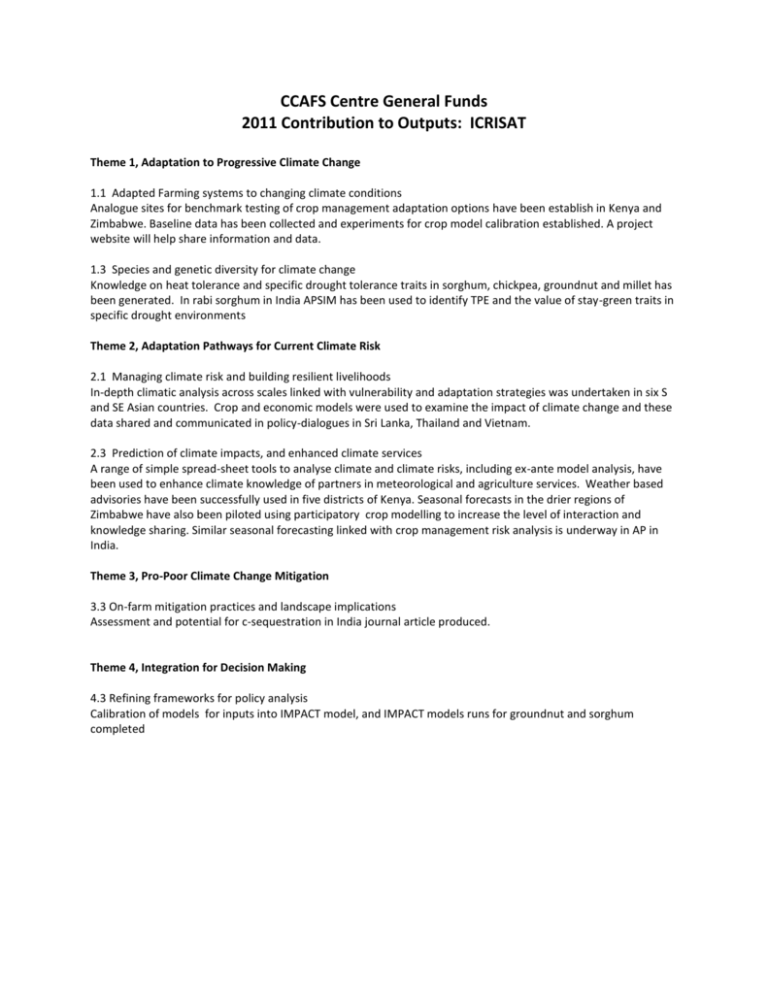
CCAFS Centre General Funds 2011 Contribution to Outputs: ICRISAT Theme 1, Adaptation to Progressive Climate Change 1.1 Adapted Farming systems to changing climate conditions Analogue sites for benchmark testing of crop management adaptation options have been establish in Kenya and Zimbabwe. Baseline data has been collected and experiments for crop model calibration established. A project website will help share information and data. 1.3 Species and genetic diversity for climate change Knowledge on heat tolerance and specific drought tolerance traits in sorghum, chickpea, groundnut and millet has been generated. In rabi sorghum in India APSIM has been used to identify TPE and the value of stay-green traits in specific drought environments Theme 2, Adaptation Pathways for Current Climate Risk 2.1 Managing climate risk and building resilient livelihoods In-depth climatic analysis across scales linked with vulnerability and adaptation strategies was undertaken in six S and SE Asian countries. Crop and economic models were used to examine the impact of climate change and these data shared and communicated in policy-dialogues in Sri Lanka, Thailand and Vietnam. 2.3 Prediction of climate impacts, and enhanced climate services A range of simple spread-sheet tools to analyse climate and climate risks, including ex-ante model analysis, have been used to enhance climate knowledge of partners in meteorological and agriculture services. Weather based advisories have been successfully used in five districts of Kenya. Seasonal forecasts in the drier regions of Zimbabwe have also been piloted using participatory crop modelling to increase the level of interaction and knowledge sharing. Similar seasonal forecasting linked with crop management risk analysis is underway in AP in India. Theme 3, Pro-Poor Climate Change Mitigation 3.3 On-farm mitigation practices and landscape implications Assessment and potential for c-sequestration in India journal article produced. Theme 4, Integration for Decision Making 4.3 Refining frameworks for policy analysis Calibration of models for inputs into IMPACT model, and IMPACT models runs for groundnut and sorghum completed 2011 Activity Plan for CCAFS Centre General Funds: Activities, Deliverables & Partners CG Centre: ICRISAT Table A. Main contacts persons in the Centre Contacts Climate Change Contact Point Admin. Issues Communications Others (if needed, specify role) Name(s) (specify roles if more than one) Peter Craufurd Peter Ninnes Jerome Bossuet or Alina Paul Lieven Claessens (Alternate to Peter Craufurd) Email p.craufurd@cgiar.org p.ninnes@cgiar.org j.bossuet@cgiar.org; a.paul@cgiar.org l.claessens@cgiar.org Table B. Bilateral funded projects under CCAFS (2011) ID# 1 2 3 Name of project Vulnerability to Climate Change Adaption Strategies and Layers of Resilience - RETA 6439 Testing potential adaption strategies for rainfed agriculture in semi arid and dry sub-humid tropics Managing Risk, Reducing Vulnerability and Enahancing Productivity under Climate Change Approximate budget Donor under CCAFS (2011) (1) 644 ADB Principal investigator (also list any key contacts in EA, WA or IGP, if applicable) 490 BMZ Cynthia Bantilan (c.bantilan@cgiar.org) David Harris (d.harris@cgiar.org) 28 IDRC KPC Rao (K.P.Rao@CGIAR.ORG) Notes: (1) If a bilateral project is contributing to more than one CRP, this is only the CCAFS activities. Table C. Activity tables by Themes/Objectives Note: (1) Activities should be approximately US$250.000 in value, inclusive of all costs, i.e. including personnel, overhead etc. (2) The percentage allocation amongst regions will be used to understand where the major efforts are being directed, so that Regional Program Leaders can plan synthesis and coordination activities. They will not be used for any later reporting. (3) Milestone numbers will be provided by Theme Leaders. 2 Theme 1, Adaptation to Progressive Climate Change Milestone Activity in 2011 Deliverables in 2011 # (3) 1.1 Adapted Farming systems to changing climate conditions Analogue locations 1.1.1.1 Analysis of climate and characterisation of four important crop growing areas in Kenya and Zimbabwe and their analogue locations On station and simulation based research to iteratively test the potential of improved soil, water and crop management strategies together with contrasting crop genotypes to mitigate the impacts of increased temperature. identified and household surveys conducted in (i) cool/dry, (ii) cool/wet, (iii) warm/dry and (iv) warm/wet growing environments On-station adaptation experiments in Kenya and Zimbabwe initiated 2 female PhD students registered at Hamburg Capacity building through 2 PhD programmes initiated Status of the activity /deliverable Partners On-station experiments to evaluate the performance of selected crops, varieties and management practices under different temperature regimes were established at 5 locations in Kenya – Katumani, Kampi-YaMawe, Kabete, Embu and Ol Jororok. In addition to the differences in temperature regime, Katumani and Kampi Ya Mawe represent low rainfall regimes and Kabete and Embu represent high rainfall regimes within SAT. An identical set of trials was implemented at 4 sites in Zimbabwe: Sanyati and Chiweshe, representing higher rainfall areas; Chiredzi and Matobo, representing lower rainfall areas. Experiments were initiated to evaluate the performance of three different varieties representing different maturity groups (early, medium and late) of maize, sorghum, beans, and pigeonpea; to assess effectiveness of fertilizer use with and without soil and water conservation on sorghum and maize; to evaluate the effect of plant population on performance of pigeonpea and beans with and without soil and water conservation; and to evaluate the effectiveness of seed priming, with water and with P, on four test crops under early and delayed planting conditions. The first season results will be available in March (Kenya) and May (Zimbabwe) 2012. Questionnaire-based baseline surveys of communities at each of 8 sites have been completed and data are being analysed. Two female PhD students, one in Kenya and one in Zimbabwe, have started their studies focusing on gender dimensions of climate change A project website was established and one information leaflet and one newsletter were published. NARES: Kenya Kenyan Meteorological Dept (KMD). Kenya; Kenyan Agricultural Research Institute (KARI), Kenya; Zimbabwe Meteorological Department (ZMD). Zimbabwe; Midlands State University, (MSU) Zimbabwe Heat tolerance In 2011, a pearl millet nursery comprising of 85 advanced breeding lines and 2 populations was planted in three diferent datesin summer to coincide the high temperature of ≥ 42 ºC at flowering in at least one of the planting dates. This nursey was evaluated at 6 locations across 3 Indian states ( Rajasthan, UP, and Gujarat). ARI: University Western Australia ARI: Hamburg University, Faculty of Life Sciences, Germany 1.2 Breeding strategies for future climatic conditions 1.3 Species and genetic diversity for climate change Pearl millet & chickpea 1.3.1.1 Mini-core/reference/ association panels of ICRISAT mandate crops phenotyped for heat and oher climate change adaptive traits mini-core Plus collections screened for heat tolerance Groundnut and chickpea 3 mini-core collections screened for root and drought traits Heat tolerant lines (maintainers, B-lines, germplasm, composits) were identified with >60% seed set when the air temperature during flowering exceeded ≥42◦C. In addition, four B-lines (ICMB 00333, ICMB 02333, ICMB 03555, and ICMB 04999 which were earlier identiifed as heat tolerant in 2010) again confirmed to be heat tolerant. These lines and a hreat tolerant composit will be tested in 2012. Water use Sorghum, chickpea and groundnut mini-core have been screened for root-related traits (capacity to extract water using a lysimetric system) and the capacity to limit transpiration under conditions of high VPD, which saves water. Germplasm showing transpiration sensitivity to high VPD have been identified, and these also show a positive relationship to their degree of tolerance to terminal drought. TPE has been defined for rabi sorghum in India and effect of staygreen and other water use related traits modeled in APSIM Crop simulation modelling has been started in chickpea to evaluate the effect of root traits on seed yield and to assess whether crop phenology matches latitude for chickpea adaptation 4 Theme 2, Adaptation Pathways for Current Climate Risk Milestone Activity in 2011 Deliverables in 2011 # (3) 2.1 Managing climate risk and building resilient livelihoods Changes in daily climate 2.1.1.4 Analysis long term daily climate data for selected SAT locations in six countries Farm level surveys of the perception of climate change, assessment of past and present adaptation practices and understanding institutional factors Policy dialogues to provide a common platform for research, policy and other stakeholders, including grassroot stakeholders, to develop strategies for climate change analysed in four locations in India and two in each of other countries Reports on vulnerability and adaptive capacity to climate change in four ICRISAT VLS sites in India Farmers’ perceptions documented Farmers’ strategies to cope with risk and vulnerability documented Policy dialogues held in Bangladesh and Vietnam Status of the activity /deliverable In-depth climatic analysis at different scales (National, regional, districts, Mandal/tehsil and village) were undertaken to characterize long term trends in climatic variables in six partner countries. Characterized the study regions into groups based on extent of vulnerability with a set of bio-physical and socioeconomic indicators determining the exposure, sensitivity and adaptive capacity to climate change. This enabled us to prioritize the research domain towards the most vulnerable region in these countries. A series of farm survey were done to collect both quantitative and qualitative information on farmer’s perceptions of trends in climate, and the agro-socio economic context from their experience. These were analyzed and validated with a theoretical framework to compare with measured changes. Grass root level adaptation strategies were winnowed from the quantitative and qualitative data analysis from the study regions. Constraints to effective climate change adaptation were identified from the rural communities and were transformed into policy statements. The “best fit” potential adaptation strategies and constraints were described at different levels of association (household, community, national/governmental, International). A “Write Shop” was organized to validate the results from analysis and to formulate policy statements to inform the concerned authorities for action through policy dialogue in these countries. Ex-ante analysis of future climate change impacts on major crops were undertaken for major locations with validated crop models in India (Sorghum and groundnut, DSSAT) and Vietnam (Rice, and other crops, WOFOST). Economic analysis of climate change impacts on major crops on were quantified by econometric model on climate sensitivity on net farm revenue. A series of country specific policy dialogues were convened on “Building climate resilient agriculture in Asia” for Sri Lanka, Thailand and Vietnam. The policy statements were conveyed to the key persons from the ministries, government and nongovernmental organization and developmental agencies belonging to the respective countries. Partners NARES: India, Bangladesh, Thailand, China, Vietnam, Sri Lanka 5 2.2 Managing climate risk through food delivery, trade and crisis response 2.3 Prediction of climate impacts, and enhanced climate services Develop a comprehensive system Spread sheet based tools 2.3.1 that integrates locally relevant information on climate, soil, crop and market and serves as a decision aide for climate risk management in planning farm operations “Climate analyser”, “Risk analyser” and “Cost to value calculator” Risk and return profiles of investments in fertilizer, moisture conservation technologies, and improved seed More than 25 researchers from NARS in the target countries trained in use of APSIM, MarkSim, and spread sheet based tools. Weather based agro-advisory system developed and tested and its usefulness evaluated. 2.3.1.2 Linking seasonal forecast to participatory crop modelling and ICT Farmers’ perceptions of climate change and coping Three spread sheet based tools “Rainfall Analyzer”, “Temperature Analyzer” and “Cost to Value Calculator” were developed and availed to all project partners and other interested researchers and students. These tools are mainly used to conduct a quick analysis to characterize the climate of a given location using historical climate data (both observed and generated). The tools help in computing the monthly, seasonal and dekadal totals; generate descriptive statistics and plot trends. These tools are currently being updated to make them more user-friendly. An ex-ante analysis to assess risks and returns associated with selected technologies was conducted for Machakos, Makindu, Kitui, Mwingi and Mutomo in Kenya using the long-term climatic data with crop simulation model APSIM. The technologies selected for this analysis include different levels of fertilizer, soil and water conservation practices, crops and cropping systems and seasonal climate forecast based decisions. Results indicate that substantial risk exists at all the locations, except Kitui, on investments in agriculture. This is not considered in developing technologies and is acting as a major constraint in adoption of these technologies. Training programs involving project partners from Kenya, Tanzania, Ethiopia and Madagascar were conducted to familiarize them with various tools to analyze long-term climate data (spreadsheet based tools and INSTAT), methods and options to fill the missing data, climate data generation using stochastic weather generators (Marksim), and assessing impacts of variable climate on crops and identify management practices that reduce the negative impacts (APSIM). A draft training module explaining the potential applications of these tools was also developed. Three MSc students one each from UoN, Kenya; ARC, Sudan; and EIAR, Ethiopia also received training in use of crop simulation model APSIM which they were able to use in their thesis research. Weather based agro-advisories were developed and evaluated for their usefulness with farmers in five districts of Eastern Kenya. A survey conducted to evaluate the usefulness of these advisories has shown that most farmers considered advisories as extremely useful in planning farm operations, an observation well supported by a willingness of 87% of the farmers to pay for the service if required. The results are currently analyzed for publication as a journal article. Zimbabwe Tanzania, Kenya, Ethiopia, Sudan, Madagaskar Tanzania Meteorological Agency (TMA), Tanzania, University of Nairobi (UoN), Nairobi, Kenya, Kenya Meteorological Department (KMD), Nairobi, Kenya, Ethiopian Institute of Agricultural Research (EIAR), Addis Ababa, Ethiopia, National Meteorological Agency (NMA), Addis Ababa, Ethiopia, Sudan Meteorological Authority (SMA), Sudan, Agricultural Research Corporation (ARC), Sudan. NARES: Zimbabwe, India 6 & 2.3.2.3 to enhance delivery of climate information strategies in southern Zimbabwe documented Operational system of seasonal forecast delivery and ’best bet’ natural resource management options tested in Zimbabwe Piloted ICT-based advisory with seasonal forecasts and GIS maps in one District in AP, India Farmers (n=81) coping strategies in two districts of Zimbabwe (Masvingo and Hwange) have been documented along with their perceptions of climate change from household surveys and focus group discussions.Results show that farmer expectations rather than actual meteorological data influence farmers’ perceptions on climate change. However, the study finds both farmers and meteorological data reporting increases in temperatures. With Zimbabwe Met. Dept, seasonal forecasts were delivered to farmers in two districts using participatory methods. Farmers were given forecasts, forecasts plus advice, and forecast, advice plus participatory crop modelling of crop management options under different climate scenarios. Baseline and case studies were conducted. India GIS-based drought maps with rainfall scenarios have been issued to farmers in Addakkal Mandal of Mahbubnagar, Andhra Pradesh (http://vasat.icrisat.ac.in). These maps estimate the surface water available to meet village requirements (human, livestock & irrigation) and runoff. Agro-advisories, including daily rainfall, are being provided to 197 farmers through a local KVK (IT-based knowledge centre). Around 6500 SMS and voice messages have been broadcast to date. Long-term (10-16 years) cropping system experimental data for sorghum/pigeonpea and sorghum/chickpea has simulated in APSIM to quantify risk. These data are being used to evaluate ENSO phase effects as the basis of providing a seasonal forecast to farmers in two districts of AP in 2012. Zimbabwe Meteorological Department, AGRITEX, NGOs ARIs: University of Reading, University of Tasmania, Wageningen, IIT, Mumbai, IMD Theme 3, Pro-Poor Climate Change Mitigation Milestone Activity in 2011 Deliverables in 2011 # (3) 3.1. Low-carbon agricultural development pathways Status of the activity /deliverable Partners 3.2 Institutional arrangements and incentives for mitigation 3.3 On-farm mitigation practices and landscape implications Assess impact of different cropping Research paper “Carbon 3.3.1.1 systems on carbon sequestration in sequestration in Indian Paper in review for in Geoderma Life-cycle analysis of nitrogen losses in sweet sorghum at different National Soils Bureau, India 7 dryland systems in India soils of tropical and subtropical environments:Assessment and Potential” for Geoderma On-going C-seq. & NO2 measurements in cropping systems and in long-term on-station experiments N-rates completed. Evaluation of nitrous oxide emissions from a long-term Conservation Agriculture experiment at Patancheru in progress Theme 4, Integration for Decision Making Milestone Activity in 2011 # (3) 4.1 Linking knowledge with action Deliverables in 2011 Status of the activity /deliverable Partners Impact runs for groundnut completed and sorghum in progress Two popular and widely adopted sorghum and groundnut cultivars were calibrated for South Asia (India) and WCA and drought, heat tolerance and yield potential traits simulated under current climate and future climates (reported in full in CRP2) S. Nedumaran (s.nedumaran@cg iar.org) 4.2 Data and tools for analysis and planning 4.3 Refining frameworks for policy analysis 4.3.1.1 Assess impact of climate change and genetic strategies for climate change on ICRISAT mandate crops in SAsia, WCA and ESA Integrate DDSAT groundnut crop model into IMPACT model and develop new routines for adoption of new technology pathways in IMPACT Groundnut model integrated into IMPACT Experiments at Patancheru, Gulbarga and Jamnagar with four cultivars each of pigeonpea and groundnut for model calibration completed 8 Case study-CCAFS Title: Communicating probabilistic forecast information to smallholder farmers Case type: Communications Brief description of the activity: Since many agricultural investment decisions have to be made well before the growing season starts without knowing what the season is going to be, good reliable forecasts have the potential to improve farm planning and reduce risks. Despite the availability of good reliable seasonal climate forecasts, its use in in farm level decision making has not received much attention. One of the major constraints in the use of seasonal climate forecasts is lack of timely access to information in a format that can be easily understood. The forecast released by Met. Department is mainly probabilistic in nature and is not easily understood by farmers and their support agents. Result of activity: To address this problem, we have developed and tested weather based agroadvisory services to communicate the forecast information in an easily understandable format to farmers in Machakos, Makueni, Kitui, Mwingi and Mutomo districts of Eastern Kenya. The advisory is an interpretation of the seasonal climate forecast issued by Kenya Meteorological Department (KMD) and provides a succinct summary of agricultural implications of the forecast. Farmers benefitted either by being more cautious while investing in seasons predicted to receive low rainfall, or by making necessary investments in seasons predicted to receive good rainfall. In the survey conducted to evaluate the usefulness of advisories almost all farmers who have received the advisories rated them as extremely useful in planning farm operations and nearly 87% of them expressed willingness to pay for the service if required. Partners involved and their role: Key partners in this work are KMD providing forecast and related information, KARI with identifying appropriate technologies for the predicted season type and AEOs providing information on farmer preferences. Research on which the activity is based: This research is component of the work on developing strategies for effective management of climate risks by smallholder farmers (Theme 2). Web address for further information (if available): Not available 9 Title: Coping with variable climates: the use of seasonal climate forecasts and participatory simulation modeling in semi-arid Zimbabwe Case type: Example of innovative and successful communications activities Brief description of the activity: The goal of the study is to assist smallholder farmers in achieving sustained improvements in food and nutritional security through better access to climate information and the technologies and other strategies that can improve adaptation to poor years and enable them to better exploit good years. There is a need to expand the concept of agricultural extension beyond simply the use of productive inputs such as fertilizers, seed and better technologies and to include the use of information based inputs such as climate forecasts which may serve to reduce risks at farm level. This could help decision makers make better farm management decisions and prepare themselves for more effective adaptation to climate variability. Result of activity: With the Zimbabwe Meteorological Services Department, seasonal forecasts were delivered to farmers in two districts using participatory methods. Farmers were given the forecasts, forecasts + advice, and forecasts + advice + participatory crop modeling of crop management options under different climate scenarios. Case studies using a Participatory Farm Management (PFM) approach (Participatory Budgets combined with Resource Allocation Mapping) were used in quantifying and analyzing the use of resources at farm and household level, and hence the role of season crop forecast information in coping and adaptation strategies. Preliminary indications are that enhanced communication of climate related information is an important component of the options to assist in adaptation and decision making for farmers. Partners involved and their role: The Zimbabwe Meteorological Services Department (ZMD) provided/presented the forecast to the farmers and the Department of Agricultural Technical and Extension Services of Zimbabwe (AGRITEX) assisted with technical advice to the farmers. Research on which the activity is based: Theme 2.3-Prediction of climate impacts, and enhanced climate services Web address for further information (if available): Not available 10 Case study-CCAFS Title: Enhancing grass root level resilience to climate change impacts in Sri Lanka Case type: Capacity Strengthening/Communication-Policy advocacy Brief description of the activity: Villages in Puttalam, Anuradhapura and Humbantota district of Sri Lanka were studied to exam the extent of climate change and various components of vulnerability including exposure, sensitivity and adaptive capacity. Farmers’ perception with quantitative and qualitative analysis of micro-level information and then triangulation of farmers’ potential and efficient adaptation strategies and existing constraints were studied in Relevant policy options were formulated from the study findings and were mainstreamed into the developmental programs and policy. Similar activities were replicated in other partner countries, namely Bangladesh, Thailand, Vietnam, India and China. Result of activity: The analysis revealed an increasing variability in climatic characteristics in the study regions and farmers were experiencing the impact of these changes. The southern districts of Sri Lanka are highly vulnerable to climate change impacts. A set of grass-root level adaptation strategies and constraints that the farmers experienced were sketched out at different levels of interventions (household, community, National and International) embedded with sociological dimensions and governance structures. The findings resulted in formulating a set of policy needs and road map that is translated into key messages and policy statements. These were echoed in the stakeholder consultation and “Policy Dialogue” amongst the apex policy makers including ministers, planners and development practitioners. Other stakeholder includes various governmental or non-governmental organizations, research organizations, international and donor organizations, farmer’s organization, developmental and executing agencies. Partners involved and their role: The partner in this work includes Sri Lanka Council for Agricultural Research Policy (SLCARP) and climatic data sets from national meteorological stations (Metrology Department) and village level sociological information (Transparency International). Research on which the activity is based: This research is part of work on improving climate change resilience among the small holder farmers of semi arid tropics. This work is closely linked to CRP2 work component a) 1.1 for Foresight and Strategic Planning; and 1.2) Village Level Studies respectively. Web address for further information (if available): Not available 11 ICRISAT 2011 publications related to climate change for CCAFS Articles published in peer-reviewed journals listed by ISI/Thomson Reuters 1. Dixit, P.N., Cooper, P.J.M., Dimes, J., and Rao, K.P.C., 2011. Adding value to field-based agronomic research through climate risk assessment: a case study of maize production in Kitale, Kenya. Experimental Agriculture. Cambridge, 47 (2), 317-338. 2. Jagadish, S.V.K., CAIRNS, J.E., Kumar, A., Somayanda, I.M., Craufurd, P.Q. 2011. Does susceptibility to heat stress confound screening for drought tolerance in rice? Functional Plant Biology 38: 1-9 3. Jagadish, S.V.K., Muthurajan, R., Rang, Z.W., Malo, R., HEUER, S., Bennett, J., and Craufurd, P.Q. 2011. Spikelet proteomic response to combined water deficit and heat stress in rice (Oryza sativa cv. N22). Rice DOI: 10.1007/s12284-011-9059-x 4. Kesava Rao, A.V.R., and Wani, S.P. 2011. Evapotranspiration paradox at a semi-arid location in India. Journal of Agrometeorology. 13(1): June. pages. 3-8. 5. Mapanda, F., Wuta, M., Nyamangara, J., and Rees, R.M. 2011. Effects of organic and mineral fertilizer nitrogen on greenhouse gas emissions and plant-captured carbon under maize cropping in Zimbabwe. Plant and Soil, 343 (1), 67-81 (DOI: 10.1007/s11104-011-0753-7). 6. Rao, K.P.C., Ndegwa, K.Kizito W.G., and Oyoo, A. 2011. Climate variability and change: Farmer perceptions and understanding of intra-seasonal variability in rainfall and associated risk in semi-arid Kenya. Experimental Agriculture. 47: 1-25 7. Sommer, C., Zucca, A., Grainger, M., Cherlet, R., Zougmoré, Y., Sokona, J., Hill, R., Della Peruta, J., Roehrig and Wang, G. 2011. Application of indicator systems for monitoring and assessment of desertification from national to global scales. Land Degrad. Develop. 22: 184–197. 8. Varshney, R.K., Bansal, K.C., Aggarwal, P.K., Datta, S.K., Craufurd, P.Q. 2011. Agricultural biotechnology for crop improvement in a variable climate: hope or hype? Trends in Plant Science 16: 363-371. 9. Vogt, J.V., Safriel, U., Von Maltitz, V., Sokona, Y., Zougmoré, R., Bastin, G., and Hill, J. 2011. Monitoring and assessment of land degradation and desertification: towards new conceptual and integrated Approaches. Land Degrad. Develop. 22: 150-165. 12 Articles in other Peer Reviewed Journals 1. Huda, S., Victor Sadras, Wani, S.P., and Mei, Xurong. 2011. Food Security and Climate Change in the Asia-Pacific Region: Evaluating Mismatch between Crop Development and Water Availability. International Journal for Bio-resource and Stress Management (IJBSM). June 2011. 137-144. Invited Book chapters 1. Craufurd, P.Q., Jagadish, S.V.K., and Padgham, J. 2011. Impacts of climate change on rainfed agriculture and adaptation strategies to improve livelihoods. In: Integrated Watershed Management in Rainfed Agriculture (Eds SP Wani, J Rockstrom, KL Sahrawat), pp. 421-440. CRC Press, Leiden, Netherlands 13
